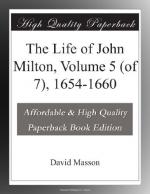now in harmony with the Secluded, and by no means
disposed to abet Hasilrig, Scott, and Marten in any
farther contest for Rump principles. In other
words, the House was now led really by the chiefs
of the reinstated members. Prominent among these,
besides Crewe, Knightley, Gerrard, Sir John Evelyn
of Wilts, Sir William Waller, Sir William Lewis, Arthur
Annesley, Sir Harbottle Grimston, and others named
as of the Council, were Prynne, Sir Anthony Irby,
Major-General Browne, Sir William Wheeler, Lord Ancram
(member for a Cornish burgh), William Morrice, and
some others, not of the Council.—Prynne,
who ought to have been on the Council, if courage
for the cause of the Secluded and indefatigable assiduity
in pleading it were sufficient qualifications, had
not been thought fit for that honour; but he was a
very busy man in the House. He had taken his
place there very solemnly the first day, with an old
basket-hilt sword on; and he was much in request on
Committees.—Of more aristocratic manners
and antecedents, and therefore fitter for the Council,
was Arthur Annesley, a man of whom we have not heard
much hitherto, but who, from this point onwards, was
to attract a good deal of notice. The eldest
son of the Irish peer Viscount Valentia and Baron
Mountnorris, he had come into the Long Parliament in
1640 as member for Radnorshire; he had gone with the
King in the beginning of the Civil War; but he had
afterwards done good service for the Parliament in
Ireland during the Rebellion, and had at length conformed
to the Commonwealth and the Protectorate. While
the Protectorate lasted he had been really a Cromwellian;
but, like so many other Cromwellians, he was now a
half-declared Royalist. He had been one of the
chief negotiators with Monk for the re-seating of the
Secluded, and he took at once a foremost place among
them, both in the House and in the Council. He
was now about forty-fire years of age.—An
accession to the House, after it had sat for a week
or more, was Mr. William Morrice. He was a Devonshire
man, like Monk, to whom he was related by marriage.
He had been sent into the Long Parliament in 1645
as Recruiter for Devonshire, and had been afterwards
secluded; and he had been returned to Oliver’s
two Parliaments and to Richard’s. Living
in Devonshire as a squire “of fair estate,”
he had acquired the character of an able and bookish
man of enlightened Presbyterian principles; he had
been of use to Monk in the management of his Devonshire
property; there had been constant correspondence between
them; and there was no one for whom Monk had a greater
regard. Now, accordingly, at the age of about
five and fifty, Morrice had left his books and come
from Devonshire to London at Monk’s request,
not only to take his place in Parliament, but also
to be a kind of private adviser and secretary to Monk,
more in his intimacy than even Dr. Clarges.—To
complete this view of the composition of the new Government,
we may add that on Feb. 24 Thomas St. Nicholas was




